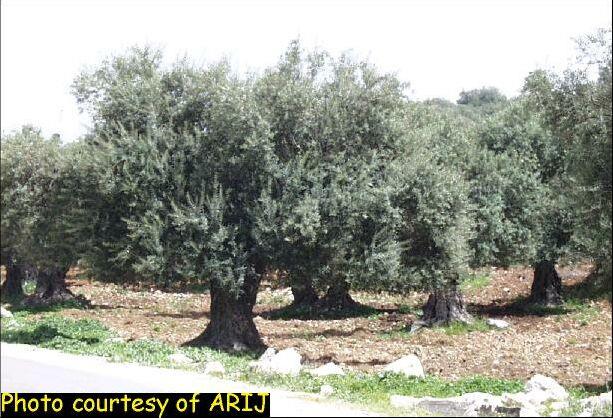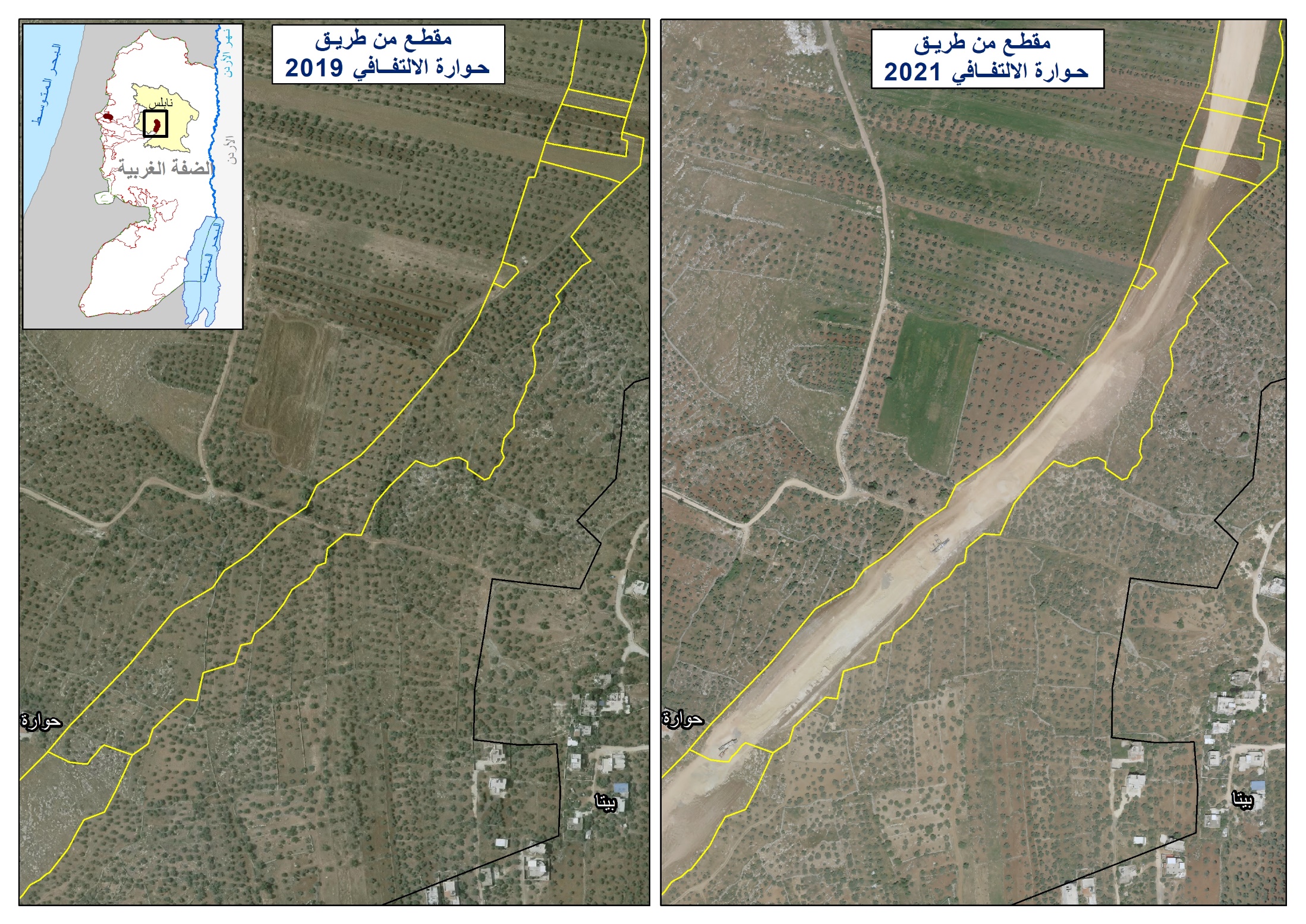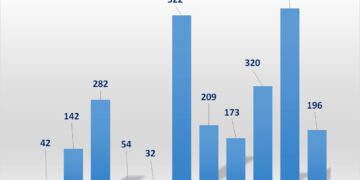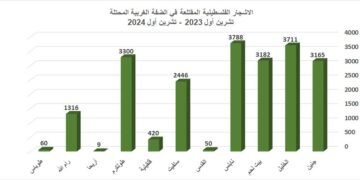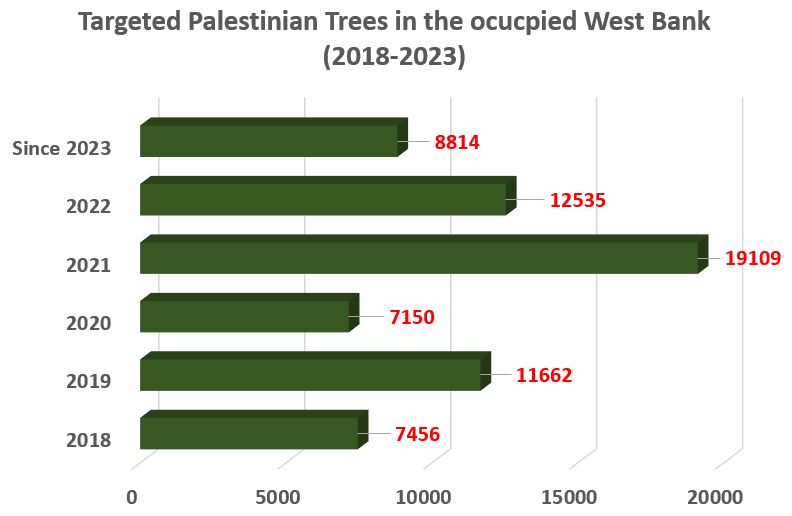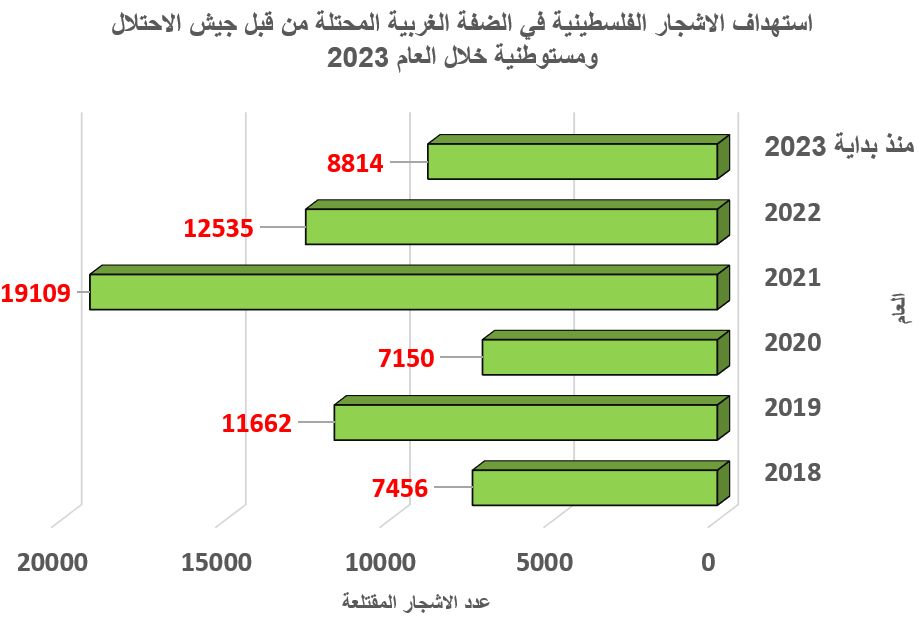Prelude:
The intensity of the war waged by Israeli forces is growing and taking different aspects and forms. Not only there have been numerous martyrdom cases and thousands of injuries, it has been documented that the Israeli government is actively trying to destroy the Palestinian economy's main pillar, agriculture, through a number of measures such as land confiscations, uprooting olive trees and preventing villagers from harvesting their olive crop (see picture). ).
The Israeli government is very well aware of the importance of olive season and that was the main reason behind the distinctive war against the olive tree and against those who harvest it throughout the West Bank and the Gaza Strip. The Israeli army also utilized the help of the heavily armed Jewish settler who usually open their machineguns fire on the villagers indiscriminately in addition to burning the crops and uprooting the olive trees.
The olive produce awaits on the trees while the Palestinian villagers are stuck between two difficult situations; either they leave the crop as is, which is doubtful as it is their main source of income, or they risk their lives trying to collect it defying, in the process, the Israeli-imposed curfew which makes the villagers a moving target for both the army and the settlers. One of the villagers said that '' it seems that we are going to pay with blood for each olive oil drop. The Palestinian olive oil this year is going to be mixed with the blood of its owner.''
The Land Research Center has documented the Israeli aggression against Palestinian agriculture between the 29th of September and the 31st of October 2000 in the following points:
-
On 28/9/2000 Israeli heavy machinery bulldozed Palestinian lands close to the Gilo Tunnel in Bethlehem. A number of trees in Beit Jala were also uprooted.
-
The 29/9/2000 was the start of two consecutive days of razing the land of Mr. Khaleel Eid Zahlan located in Abu Sukhoor region of Beit Sahour.
-
On 29/9/2000 the Palestinian inhabitants of Al Aqaba village in Jenin demanded that the Israeli Defense Ministry remove the training camp established on the land of the village. This camp is usually used by the Israeli Defense Forces (IDF) for military training using live ammunitions, military aircrafts and tanks which turns the village into a military station. These training sessions, and what they leave behind, have caused a number of fatal incidents and severe causalities over the past 20 years. It also has forced the people of the village to use mostly rough mountainous roads to get to their schools and work over the same twenty-year period. The IDF also prevents the villagers from using cement to cap their houses and it refuses to recognize Al Aqaba as a village in an effort to force the villagers to leave the village one way or the other.
-
On 30/9/2000 the Jerusalem Municipality started taking the ''legal'' steps to confiscate lands in the south and the east of East Jerusalem for the benefit of the Ring Road. The Municipality sent notifications of the confiscation to the owners of the land from the villages of Sur Baher, Jabal Al Mukabber, Al Tor and Ras Al Amoud requesting that they submit any objections in the Municipality's building. The Ring Road is expected to gobble up more than a 1000 dunums in addition to the demolishing of more than 50 homes and it aims to encircle East Jerusalem and isolate it from its West Bank heartland.
-
On 3/10/2000 a number of Israeli settlers set more than 60 olive trees afire in the village of Kafr Al Zeit – Jenin. They also destroyed agricultural equipment along both sides of the Jenin-Nazareth Road.
-
On 6/10/2000 Israeli settlers uprooted more that 100 olive trees in the village of Deir Nizam located to the south of Ramallah.
-
On 8/10/2000 Israeli settlers from the settlement of DoGheit, located to the north of the Gaza Strip, bulldozed more than 700 meters of lands belonging to the village of Beit Lahia. The settlers were supported by the Israeli army which helped them in bulldozing the land that connects the settlement to the sea.
-
On 7/10/2000 Israeli settlers destroyed a number of greenhouses and the water systems in Kardalah, Gaza.
-
On 11-12/10/2000 the DoGheit settlers- Israeli Army team destroyed about 20 dunums planted with olives, Guava, grapes and citruses that belonged to the families of Al Akka, Al Jadba, Abood, Al Ghaboon and Abu Amsha. The settler started their rampage under heavy army protection and after the area was declared as a closed military area.
-
On 12/10/2000 occupation forces prevented Palestinian teams from reconditioning 2600 meter â??long agricultural lands in the area of Seifa, Beit Lahia.
-
On 13/10/2000 a group of Ifni Heiftes settlers, Tulkarem, chased the car of Mr. Abdel Qader Adwan aiming to kill him. While trying to run away from them his car overturned causing him serious injuries. Moreover, another group of settlers from the settlement of SanaOoz, west of Tulkarem, physically battered Mariam Naifah (55 years old) while she was collecting the olive harvest.
-
On 14/10/2000 Mr. Iyad Ma'aroof Musslam (24 years old from Nablus) was kidnapped by a group of Elon Moreh settlers after being beaten up in the village of Beit Dijn while tending to his sheep. He was first taken to the settlement of Elon Moreh and then transported to the settlement of Jetit in Jericho. The kidnapers left him in the car at a military checkpoint and ran away. The military personnel at the checkpoint let Musslam free who had to go back to the nearby Aqraba village on foot. The next morning he headed back to his village after the 20-hour ordeal.
-
On 25/10/2000 the Israeli company ''Ijrasco'' informed Gazan farmers who grew strawberries that they can no longer export their product through Beit Hanoon and that they have to export it through Karni crossing point instead. This change of policy will cause the product to become spoiled, causing in the process an estimated damage of about US$12,750,000 for the strawberry industry in the Strip according to the following calculation:
Cost of planting and maintaining 1500 dunum of strawberry = US$ 5,250,000
Cost of Production of the 1500 dunum of strawberry = US$ 7,500,000
Total losses = US$ 12,750,000
Such a scenarion is duplicated with regards to the flowers industry in the Strip
wherein 650 dunums are planted with delicate flowers. In the case of the
continuation of the closure, the total losses for the flower sector is expected to be
US$ 11,830,000.
-
On 15/10/2000 a group of settlers set ablaze a wood store that belonged to Mr. Khaleel Basheer in Deir Al Balah. They also prevented the fire truck from reaching the place of the incident in addition to shooting at the people who were trying to put the fire out. Three citizens suffered gunshot wounds.
-
On 17/10/2000 Jewish settlers of the Old City in Jerusalem tried to occupy the residence of the heirs of Mr. Dawood Khaleel Abu Farha in Al Sa'idiyah neighborhood of the Old City. Earlier they have tried to takeover the house of Mr. Mohammad Al Kurd in the Sheikh Jarrah neighborhood.
-
On 18/10/2000 Israeli occupation forces established a new checkpoint on lands belonging to the village of Al Qarara close to the Khan Yunis's southern entrance. The land is situated on the Al Qarara – Kisofeem settlement road which the same road connecting the settlement of Gush Qateef with the Greenhouses Line.
-
On 18/10/2000 Israeli heavy machinery bulldozed 26 dunums filled with olive and citrus trees at Al Shuhada crossroads' four directions. It also demolished a well used to water 150-dunum lands in addition to 5000 sheep. Moreover, Israeli forces totally demolished the two residential towers that were located next to the Shuhada crossroad at midnight after heavily bombarding it for several days. Furthermore, the wall next to which Mohammad Al Durrah was killed in cold blood on 30/9/2000 was eradicate to erase any memory of that reprehensible crime seen by millions throughout the world.
-
On 18/10/2000 a group of Israeli settlers set ablaze tens of olive-tree-filled dunums in the village of Kafl Hares.
-
Palestinian farmers in general were prevented by either Israeli army andor settlers from harvesting their olive crop especially in the districts of Nablus, Salfeet, Tulkarem, Qalqilia, Jenin and Ramallah. This policy led to the slaying of the martyr Fareed Nasassareh from the village of Beit Foreek, Nablus, while he was picking olives in addition to the injury of four of his relatives and tens of other villagers. A similar scenario took place in the village of Al Zawiya to the south of Nablus.
-
Also on 18/10/2000 Israeli heavy machinery bulldozed 35 dunums along the main street north of Gaza and close to the Eretz crossing point. Afterwards, it placed concrete blocks along the same road.
-
On 19/10/2000 Israeli authorities confiscated 6 dunums in Jericho that belonged to Mr. Eid Zuhdi Abdel Razeq from Tubas and established on it greenhouses. It also prevented the villagers of Habla from reaching their greenhouses by opening gunfire on them.
-
Israeli forces took possession of what amounted to 250 dunums in Al Mawasi area of Khan Yunis for the purpose of the expansion of Neve Dekalim settlement. Eighty of these dunums were barbwired while the rest were put in reserve with the intent of building 500 greenhouses on them.
-
On 20/10/2000 Israeli forces uprooted about 200 trees along both sides of the main road close to Eretz crossing point to the north of Gaza.
-
On 20/10/2000 a group of Israeli settlers, in direct coordination with Israeli military teams, prevented the family of Al Astal from harvesting their Guava produce from their 400-dunum land located in Al Mawasi area of Khan Yunis.
-
Huge losses were encountered by the agricultural sector in Gaza due to the cancellation of contracts with orthodox Jews who refuse to plant their land this year due to its religious nature. It is a well-known fact that orthodox Jews stop planting their land once every seven years. Such losses hover around US$ 20 million.
-
On 21/10/2000 the Jerusalem Municipality issued a statement declaring its intention to establish a new neighborhood in the settlement of Neve Yaqoob to the north of East Jerusalem.
-
On 22/10/2000 Israeli forces in coordination with settler from Gush Qatif destroyed more than 30 dunums in Khan Yunis. It also rendered useless a water well used to provide water to 100 dunums in addition to 6000 sheep.
-
On 22/10/2000 Israeli forces bulldozed a number of dunums of Beit Jala lands close to the by-pass Road 60, uprooting in the process a number of olive trees.
-
On 27/10/2000 Israeli authorities informed a number of Palestinian families that they have to uproot olive, citrus and palm trees they own in a 100-dunum land located close to the Green Line and close to the settlement of Kfar Darom in Deir Al Balah, Gaza.
-
Both Israeli forces and settlers got into the deadly habit of planting suspicious and explosive items through a number of olive fields that are located close military camps and colonies. A number of fatal casualties and injuries were reported especially in the cases of children.
-
Israeli settler dug up a number of citrus and palm trees next to Al Mintar crossing point to the east of Al Shijaiyah, Gaza, under the pretext of ''Security Reasons.''
-
A report published by the Palestinian Ministry of Agricultures indicated that occupation forces uprooted 1400 olive, citrus, palm and shrubbery trees in the Gaza Strip.
-
On 28/10/2000 Israeli forces bulldozed 80 dunums in Gaza city. That is in addition to the demolishing of water tanks located close to Al Mattahen cross road. Moreover, 500 orange and 1000 olive trees were uprooted in a farm co-owned by the Farra and Abdeen families.
-
On 30/10/2000 a number of dunums were bulldozed in the villages of Aneen and Umm Al Rihan in Jenin and close to the colnies of Shakeed and Hananeet. Mobile homes were put on these dunums in an effort to prevent Aneen villagers from harvesting their olives.
-
Also on 30/10/2000 Israeli occupation forces took the initial steps of establishing ten alternative by-pass roads some of which were located in the ''A'' area.
-
Also on 30/10/2000 tens of olive-tree-filled dunums were bulldozed close to Al Mintar, Gaza.
-
It was announced that on the first of January 2001 the Jerusalem Municipality is to discuss a plan to build a new settlement between Jerusalem and Bethlehem on a land that was confiscated earlier close to Mal Ilias Monastery. The settlement is expected to have 400 housing units. Discussions will also include the issue of executing the second phase of the Abu Ghunaim settlement which calls for the building of 4000 housing units.
-
On 31/10/2000 Israeli forces uprooted more than 150 olive trees in Deir Balllot after declaring the area a Militarily Closed Zone. The trees were owned by Ameen Amer, Abdel Al Ghafer Abdel Hameed and his brothers in addition to Ibraheem Odeh and brothers.
-
On 31/10/2000 survey works were carried out in the lands of the villages of Iskaka and Yasuf, Salfeet. The goal was to enlarge the street leading to the settlement of Ariel. It is worth mentioning that the road is expected to be 20 meters wide.
-
On 31/10/2000 Israeli engineers bulldozed lands in Al Ouja in preparation to elrage Road 90 to become 12-meter wide. The result of the bulldozing was the destruction of the water distribution net in addition to the obliteration of the main canal associated with Al Ouja spring.
-
On 31/10/2000 Israeli forces demolished everything that the family Abu Dhaheer owned in Rafah. The destroyed items included 60 greenhouses, 20 olive trees, 4 water wells, 13 agricultural pools (150 cubic meters capacity), in addition to the water canals in 65 dunums and 13 water pumps.
-
On 31/10/2000 occupation heavy machinery established a road around the settlement of Dojeet in the Seifa area of Gaza, destroying in the process huge tracks of land. On 31/10/2000 each of Abdel Latteef Noful, Abdel Qader Walwail and Abdel Raheem Salsa'a, all Qalqilia natives, were informed that 8 dunums of their tree-filled land is to be bulldozed soon.
-
On 31/10/2000 it was announced that the Jerusalem Municipality is going to discuss the issue of building a new settlement on a 64-dunum piece of land in Abu Dies.
Economically speaking, the recent steps and the series of aggressive acts carried out by both Israeli forces and settlers have seriously damaged the Palestinian economy. Data collected by the LRC in cooperation with the Union of Agricultural Committees indicates that the agricultural sector in Gaza has endured a great sum of losses on a number of fronts such as the following:
-
The complete blockade of commercial movement between the Gaza Strip and each of the West Bank and Israeli (and vice versa). Exports from Gaza to the rest of the world were also blocked. The blockade from Gaza to Israel was lifted for only one week after Israel have failed to satisfy the needs of its own markets from Israeli-produced vegetables or imported vegetables
-
The attempt by Gush Qateef settlers to market outdated and spoiled insecticides to Palestinian farmers in the Strip.
-
The restrictions on importing chicken and sheep feed and the obstruction of trading in agricultural chemicals which led to damages in the animal and agricultural fields.
-
The obstruction of the work of the Union of Agricultural Committees which usually give directions and supervision to the local farmers, and finally we found that..
-
The unemployment in the Gaza Strip has jumped to 65-68%.
Thus, we find at the LRC that Israel has chosen to wage war against the Palestinian people not only in the battlefields but also in the olive fields. This food war exposes only another facet on Israel's ugly true face.
Prepared by
The Land Research Center
LRC


